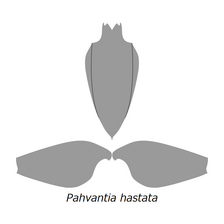帕凡特蝦屬
| 覆矛帕凡特蝦 | |
|---|---|

| |
| 科学分类 | |
| 界: | 动物界 Animalia |
| 门: | 节肢动物门 Arthropoda |
| 纲: | †恐蝦綱 Dinocaridida |
| 目: | †放射齒目 Radiodonta |
| 科: | †赫德虾科 Hurdiidae |
| 属: | †帕凡特蝦屬 Pahvantia Robison & Richards, 1981 |
| 种: | †覆矛帕凡特蝦 P. hastata
|
| 二名法 | |
| †Pahvantia hastata Robison & Richards, 1981
| |
覆矛帕凡特蝦(學名:Pahvantia hastata)是帕凡特蝦屬(學名:Pahvantia)的唯一個物種,生活在中寒武紀,現在已滅絕。帕凡特蝦的頭部骨片很細長,兩側對稱,形狀類似矛。頭部骨片突出的圓形的部分是整個骨片後面最寬的地方,大約位在頭部骨片的約為三分之一。頭部骨片側邊往下收縮,兩個柄狀突起幾乎平行,後面的部分邊緣比較尖銳,[2]全身大約低於25公分。[3]與其他的赫德蝦一樣,都有3個骨片。[4]濾食性動物的小型奇蝦與篩蝦屬(Tamisiocaris)[5]和海神盔蝦屬(Aegirocassis)一樣[3][6],可能可以微型浮游生物(包括大型浮游植物)或是以懸浮在水中的食物顆粒為食。[3][7]魯迪·勒羅西-奧布里爾(古生物學家,Rudy Lerosey-Aubril)和史蒂芬·帕茨(古生物學家,Stephen Pates)發現到帕凡特蝦的附肢,可以加確定帕凡特蝦是奇蝦的一種。[3]
命名與發現
Pahvantia是由美國猶他州的西部美洲原住民(印地安人)稱作帕凡特(Pahvant)轉變而來,種小名hastata則是源自拉丁文的hastatus,意思是茅、劍的意思。[2]帕凡特蝦來自美國猶他州的房屋山脈(House Range)和車夫頁岩(Wheeler Formation)。[2][3][1]Robison和Richards發現KUMIP 134878、KUMIP 134187和KUMIP 134879,[2]Pates和Rudy發現KUMIP 134187,KUMIP 314089, KUMIP 314090[3](帕凡特蝦的附肢和頭部骨片化石,KUMIP是Museum of Invertebrate Paleontology University of Kansas的簡寫)。[2]
型態
骨片
頭部骨片(H骨片)的尖矛形或是披針形的輪廓,前面有一根微小的矢狀刺,後面的邊緣是鋸齒狀。[2]側面骨片(P骨片)整體很細長,後面的邊緣有稍微凹陷和前面的突出物呈鉤形(這個鉤形是P骨片用來連接的部分,稱作P骨片頸[8][9])。[2][3]帕凡特蝦的頭部骨片(H骨片)與其他物種,例如:海神盔蝦屬,類似三角形的形狀。雖然帕凡特蝦如其他的赫德蝦一樣在骨片後有眼凹口(ocular notch,眼睛所在之處)但是大小比起顯爪蝦和巨盔蝦的眼凹口還小了許多。[9]

有保存問題的附肢


梗末節(peduncle,指附肢的梗節最靠近頭部的節)特別狹窄,末端變寬,可能是地層的傾斜方向和/或不完整的保存。一開始Rudy和Pates發現的附肢化石中,由於保存問題,只能猜測大約有5個分節(podomere)。
Rudy和Pates發現大量的長毛狀結構,當時將其稱為剛毛(setae)。在更靠近頭部有類似前附肢棘(endite,指附肢上的棘)的形狀,與其他的前附肢棘有很大差異。靠近頭部的兩個前附肢棘是短而堅固的板狀結構,每個都有七個排列成兩排的前附肢輔刺(auxiliary spines,指前附肢棘上還有更小的刺)。[3]吉恩-貝爾納·卡隆(Jean-Bernard Caron)和約瑟夫·莫伊休克(Joseph Moysiuk)將此稱作"一種不尋常的附肢類型",認為此附肢存在著許多問題。首先,沒有證據表明節(podomere)與細長的類似剛毛的「前附肢棘」相關,並且這些「前附肢棘」不規則彎曲,沿其長度不同程度地彎曲,表明它們具有高度柔韌。可是在其他的赫德蝦裡通常不會前附肢棘以這種方式變形。之後重新給出附肢的特徵。「附肢有五個長度相似的前附肢棘,每個前附肢棘可能有七到八個堅固的鉤狀次等刺(secondary spines),並在末端有類似的鉤狀次等刺。」且一開始Rudy和Pates所說的"兩個前附肢棘"其實是三個前附肢棘被壓縮堆疊而成的。最末端的第六個前附肢棘被忽略,並且大部分保留在對應部分上(只有其尖端在顯露出來)以及分節的背側部分。其實真正的附肢大約是Rudy和Pates先前描述的結構最大尺寸的一半。Rudy和Pates所描述的推測的剛毛,其實與鰓的結構更相似,這些結構不是附肢的一部分,也不太可能用於進食,比較大的可能性是用於呼吸。[10]
分類
| 赫德蝦科Hurdiidae |
| |||||||||||||||||||||||||||||||||||||||||||||||||||
資料來源
- ^ 1.0 1.1 Wu, Yu; Pates, Stephen; Ma, Jiaxin; Lin, Weiliang; Wu, Yuheng; Zhang, Xingliang; Fu, Dongjing. Addressing the Chengjiang conundrum: A palaeoecological view on the rarity of hurdiid radiodonts in this most diverse early Cambrian Lagerstätte. Geoscience Frontiers. 2022-11, 13 (6). ISSN 1674-9871. doi:10.1016/j.gsf.2022.101430.
- ^ 2.0 2.1 2.2 2.3 2.4 2.5 2.6 Robison, Richard A.; Richards, Beverley Cobb. Larger bivalve arthropods from the Middle Cambrian of Utah. 1981-12-16. ISSN 0075-5052 (美国英语).
- ^ 3.0 3.1 3.2 3.3 3.4 3.5 3.6 3.7 Lerosey-Aubril, Rudy; Pates, Stephen. New suspension-feeding radiodont suggests evolution of microplanktivory in Cambrian macronekton. Nature Communications. 2018-09-14, 9 (1) [2023-12-13]. ISSN 2041-1723. doi:10.1038/s41467-018-06229-7. (原始内容存档于2021-10-07).
- ^ Caron, J.-B.; Moysiuk, J. A giant nektobenthic radiodont from the Burgess Shale and the significance of hurdiid carapace diversity. Royal Society Open Science. 2021-09, 8 (9) [2023-12-16]. ISSN 2054-5703. PMC 8424305
 . PMID 34527273. doi:10.1098/rsos.210664. (原始内容存档于2022-09-24) (英语).
. PMID 34527273. doi:10.1098/rsos.210664. (原始内容存档于2022-09-24) (英语).
- ^ Vinther, Jakob; Stein, Martin; Longrich, Nicholas R.; Harper, David A. T. A suspension-feeding anomalocarid from the Early Cambrian. Nature. 2014-03, 507 (7493). ISSN 0028-0836. doi:10.1038/nature13010.
- ^ De Vivo, Giacinto; Lautenschlager, Stephan; Vinther, Jakob. Three-dimensional modelling, disparity and ecology of the first Cambrian apex predators. Proceedings of the Royal Society B: Biological Sciences. 2021-07-21, 288 (1955). ISSN 0962-8452. doi:10.1098/rspb.2021.1176.
- ^ Potin, Gaëtan J.-M.; Gueriau, Pierre; Daley, Allison C. Radiodont frontal appendages from the Fezouata Biota (Morocco) reveal high diversity and ecological adaptations to suspension-feeding during the Early Ordovician. Frontiers in Ecology and Evolution. 2023-08-09, 11. ISSN 2296-701X. doi:10.3389/fevo.2023.1214109.
- ^ Daley, C; Budd, E; Caron, C; Edgecombe, D; Collins, C. The Burgess Shale anomalocaridid Hurdia and its significance for early euarthropod evolution (project). MorphoBank datasets. 2014 [2024-01-27].
- ^ 9.0 9.1 Moysiuk, J.; Caron, J.-B. A new hurdiid radiodont from the Burgess Shale evinces the exploitation of Cambrian infaunal food sources. Proceedings of the Royal Society B: Biological Sciences. 2019-07-31, 286 (1908). ISSN 0962-8452. doi:10.1098/rspb.2019.1079.
- ^ Caron, J.-B.; Moysiuk, J. A giant nektobenthic radiodont from the Burgess Shale and the significance of hurdiid carapace diversity. Royal Society Open Science. 2021-09, 8 (9) [2023-12-16]. ISSN 2054-5703. PMC 8424305
 . PMID 34527273. doi:10.1098/rsos.210664. (原始内容存档于2022-09-24) (英语).
. PMID 34527273. doi:10.1098/rsos.210664. (原始内容存档于2022-09-24) (英语).
- ^ Moysiuk, Joseph; Caron, Jean-Bernard. A three-eyed radiodont with fossilized neuroanatomy informs the origin of the arthropod head and segmentation. Current Biology. 2022-08, 32 (15). ISSN 0960-9822. doi:10.1016/j.cub.2022.06.027.












